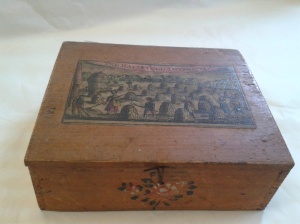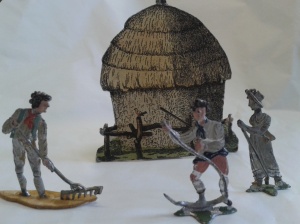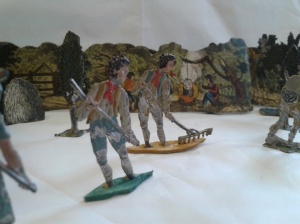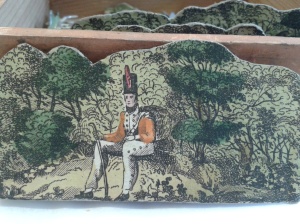Toy ‘Dissected Hayfield’ acquired by City of Edinburgh Council in 1975 with an NFA grant of £12.
Looking through a list of objects acquired by the Museum of Childhood with NFA support, I was intrigued to see one object described as a ‘Dissected Hayfield’ and wondered what it could be. I checked its location and found it was stored with Construction Toys, which piqued my interest even more. Early jigsaw puzzles were sometimes called dissected puzzles but we normally associate construction toys with Lego, Meccano, etc.
I found this simply made and decorated wooden box in the store and had a look inside. It contained a large number of painted tin figures and printed paper scenery, all on little stands so that you could set them up and arrange them as you wish. The printed illustrations on the paper, such as the haystack, were reminiscent of paper theatres and their scenery and, judging from the women’s dresses and soldier’s uniform, the toy was made around 1820-30, when toy theatres were also popular. This means the toy predated, or was contemporary with, the earliest dissected jigsaw puzzles which makes it a rare item marking an interesting development in children’s toys.
This toy would almost certainly have been made in Germany which began exporting toys in the late 18th century and was the leading manufacturer of mass produced toys, often cheaply made from tin and wood, until the First World War. By 1907 Germany was using so much tin in its toy manufacturing that it had to import from South Wales and elsewhere to satisfy demand.
Children’s toys often replicate what is in the world at a given time, reflecting technology, fashion, war, occupations, etc. In this toy you can see what a woman, a soldier and a farm worker would have worn at this period, and the tools the farm workers would have used. Even the shape of the haystacks can give us an idea of when the toy was made.
Was the toy instructional? Or purely intended for pleasure and passing leisure time? Either way it would not have been a toy for poorer children, who had to make do with homemade toys, but would have been intended for the nursery of a wealthy family with disposable income to spend on such luxuries. Many of the poorer children in rural areas would have worked alongside their families in real hayfields.
Lyn Wall
Curator
Museum of Childhood
http://www.edinburghmuseums.org.uk




